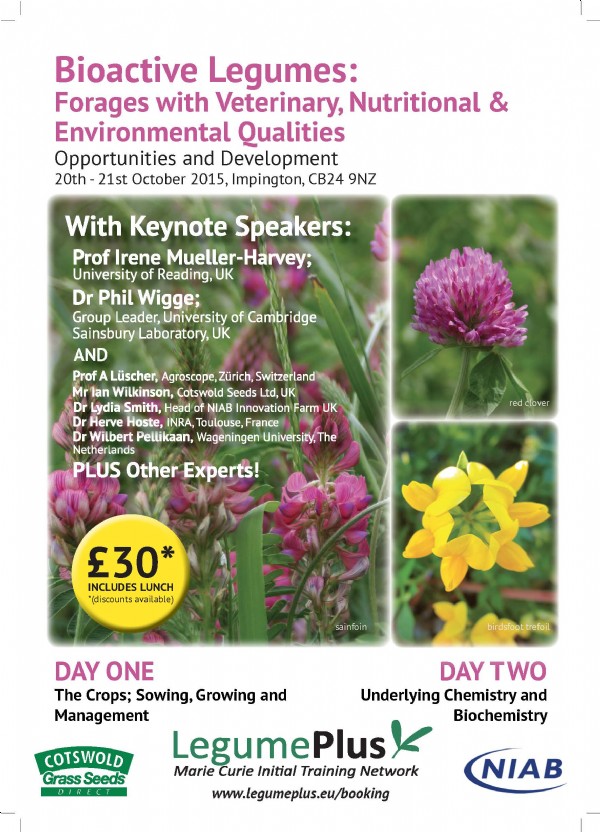

As the four-year-long LegumePlus project comes to a close, highlights of the key findings are now available, in advance of the dissemination event to be held in October 2015.
Parasitology
- Scientists in the EU-funded research project LegumePlus and their collaborators have found that a wide range of condensed tannins from legumes and other plants can act against gastro-intestinal nematodes (parasitic worms). These parasites are commonly found in farm animals (sheep, goats, cattle and pigs) and sometimes also in people.
- Most of these studies demonstrated promising nematicidal (or ‘anthelmintic’) activities of these plant tannins in the laboratory. However, some studies also found that sainfoin could reduce the worm burdens in animals.
- This anthelmintic activity is enhanced by the addition of quercetin or luteolin, which are two natural compounds that occur in many green plants.
- The effect of these condensed tannins is more pronounced against the blood-sucking Haemonchus contortus than the intestinal Trichostrongylus colubriformis parasite. Interestingly, prodelphinidin-type tannins produce a greater anthelmintic activity than procyanidin-type tannins. There is also a potent effect against the Ascaris suum pig worm (A.R. Williams, Copenhagen University), and on the brown stomach worm Ostertagia ostertagi. As well as sainfoin, tannins from plants such as chicory and carob pods have been shown to have strong anti-parasitic effects.
- Collaborators in Greece (S. Sotiraki) and the USA (T. Terrill and colleagues) have found that the tannin-containing forage legumes, sainfoin and sericea lespedeza, have also excellent potential as a natural anti-coccidian feed for both goats and sheep.
Ruminant Nutrition
- It is also interesting to note that the protein in silages made from tannin-containing legumes such as sainfoin is better conserved than in pure grass silages, and that the addition of these legumes improves both silage quality and ruminal digestion.
- Sainfoin decreases ruminal protein degradation and metabolic stress by lowering ammonia load. It has an effect on the ruminal community, but it is not clear yet if this is due to a direct effect on the microbes or due to an effect on the nutrient availability.
- Feed intake and milk production were both increased in sainfoin fed animals. Methane production per day and per kg dry matter intake was not affected, but methane produced per kg milk tended to decrease. This suggests that sainfoin fed animals may have a lower environmental footprint.
- Lambs fed sainfoin or birdsfoot trefoil produced meat containing more polyunsaturated fatty acids (PUFA), and less saturated fatty acids (SFA). The meat of lambs fed sainfoin also contained less skatole, and thus had a more appealing flavour than grass-fed lambs.
- Milk from cows fed sainfoin contained less urea, and more of the beneficial C18:3 PUFA.
Plant Breeding and Agronomy
- In terms of developing improved sainfoin plants, we have found there was no significant negative correlation between condensed tannin concentrations and yields, i.e. some varieties can have increased forage yields and condensed tannin levels, and secondly, no important negative correlation occurred between plant size and their leaf to stem ratio. This is important, as the leaves had up to five times more condensed tannins. In terms of soil pH, sainfoin performed best on soils with a pH of 7.0 to 7.5, but it also grew on soils with slightly lower or higher pH values.
- Work on marker development has been undertaken: a framework map has been established, and sequencing completed. We have found marker trait associations for plant height, mass, flowering time and seed yield.
Tannin Chemistry
- To add to these veterinary, nutritional and environmental benefits, LegumePlus has developed a range of chemical analysis techniques. Ultra-performance liquid chromatography-tandem mass spectrometry (UPLC-MS/MS) is uniquely suited to qualitatively and quantitatively analyse condensed tannins collected directly from crude plant extracts. A newly developed 1H-13C-HSQC NMR spectroscopy method now allows us to determine the procyanidin/prodelphinidin and cis/trans–flavanol ratios of condensed tannins in extracts and in solid samples. In addition, a widely used tannin assay, the HCl-butanol method, has been much improved by conducting the reaction in the presence of acetone.
- Taken together, such techniques will allow us in future to rapidly screen large numbers of plants, to chemically ‘fingerprint’ soluble condensed tannins and to monitor changes that occur during the processing of tanniniferous plants and forages.
A more detailed summary is also available by clicking here
Researchers involved in the project will be presenting their research and talking about their findings at the Dissemination Event in October. They will be joined by keynote speakers from the world of agriculture. http://legumeplus.eu/booking
Date Posted: 30th September 2015



